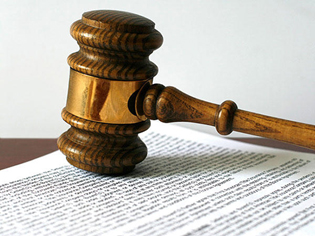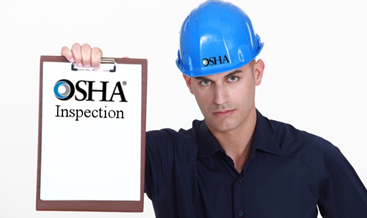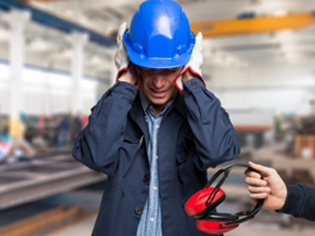Noise Compliance Issues & Standards
Employee Noise Concerns and OSHA/NIOSH Noise Compliance
OSHA and NIOSH Noise Compliance
Noise compliance issues as required by OSHA or NIOSH standards
High noise levels in plants or businesses can cause hearing damage, and in some instances are an impediment to safety (inability to hear warnings or alarms) and are a direct link to added workplace physical and psychological stress. High noise can also reduce productivity and concentration.
Noise may be a problem in your workplace if:
- Employees experience ringing or humming in the ears when leaving work.
- Workers must shout to be heard by a coworker an arm’s length away.
- Employees experience temporary hearing loss when leaving work.
- Noise complaints have become frequent
- Issues are noted regarding reduced productivity

Legal Requirements
In order to protect workers’ hearing, two organizations have determined allowable noise limits:
OSHA (Occupational Safety and Health Administration). OSHA is part of the United States Department of Labor. The administrator for OSHA is the Assistant Secretary of Labor for Occupational Safety and Health. OSHA’s mission is to ensure safe and healthful working conditions for workers by setting and enforcing standards and by providing training, outreach, education and assistance. Standards for allowable noise limits in production facilities were first published in 1972. OSHA personnel are also empowered to perform noise audits at any site at their discretion, particularly when complaints are received by employees.
OSHA has established legal limits for noise exposure in the workplace. These limits are based on a worker’s 8-hour time-weighted average (TWA) exposure over a work day. OSHA’s permissible exposure limit (PEL) is an 8-hour TWA noise level of 90 dBA. The allowable time of exposure is reduced by half for each 5 dBA increase. For example, if workers are exposed to noise for four hours, the exposure limit would be 95 dBA TWA. Peak noise levels (e.g. ‘impact’ sounds) are limited to 140 dB (unweighted) with no dependency on the duration of the noise impulse.
OSHA’s standard dictates that when employees are exposed to noise levels exceeding the PEL, feasible engineering and/or administrative controls must be used to reduce noise levels. Engineering controls reduce noise levels through modification of equipment or the work area, such as installing mufflers or noise barriers. Administrative controls are management decisions on work activities, work rotation, and workload to reduce workers’ exposure to hazardous noise levels. If such engineering and administrative controls fail to reduce sound exposure levels below the established limit, then personal protective equipment (PPE) is mandated to reduce sound to permissible limits.
OSHA also requires employers to implement a Hearing Conservation Program (HCP) whenever workers’ noise exposures equal or exceed an 8-hour TWA sound level of 85 dBA, also known as the Action Level (AL).
HCP actions can include:
- Notifying employees of hazardous noise levels
- Allowing employees the ability to observe noise monitoring measurements
- Maintaining an audiometric testing program for all workers, including a baseline audiogram
- Making hearing protection available to all affected employees
- Developing a noise training program
In addition, 28 states operate their own OSHA-approved health and safety programs, which may have different requirements.
 As stated previously, OSHA auditors can acquire noise readings or exposure studies at any commercial or industrial site to determine noise exposure levels. A warning can be issued if the requirements stated above are not met, and failing to comply with these requirements after the warning is issued can result penalty fines of up to $14,000.00 per violation (depending on the size of the facility). If the violation is not promptly resolved after a violation has occurred, additional fines can then be levied at up to $14,000.00 per day until compliance is achieved. While fines at this level are rare, several large corporations have experienced this situation, costing them hundreds of thousands of dollars until the noise matters were resolved.
As stated previously, OSHA auditors can acquire noise readings or exposure studies at any commercial or industrial site to determine noise exposure levels. A warning can be issued if the requirements stated above are not met, and failing to comply with these requirements after the warning is issued can result penalty fines of up to $14,000.00 per violation (depending on the size of the facility). If the violation is not promptly resolved after a violation has occurred, additional fines can then be levied at up to $14,000.00 per day until compliance is achieved. While fines at this level are rare, several large corporations have experienced this situation, costing them hundreds of thousands of dollars until the noise matters were resolved.
NIOSH (National Institute of Occupation Safety and Health) Recommendations
While OSHA creates and enforces regulations, NIOSH focuses its attention on advancing the scientific field of occupational safety. They share the results of their research with OSHA and support noise control requirements via comprehensive noise analysis and human hearing loss studies. They also provide workplace training to improve safety at businesses. NIOSH does not enforce their recommendations.
NOISH recommends that employee noise exposure remain at or below 85 dBA TWA over an eight-hour workday. Employees exposed to higher noise levels should wear hearing protection. Suggestions are also provided to support the implementation of engineering noise controls in those situations where high noise levels are present.
Employee Noise Concerns
Noise complaints from employees should be investigated to assure that the OSHA requirements are fully met so as to assure that potential hearing-loss concerns are promptly addressed. In some instances, employees may express noise-related concerns even when the workplace noise levels are fully compliant with OSHA and NIOSH recommended limits.
 Noise perception and noise annoyance are both psychological and subjective phenomena. While noise annoyance criteria are standardized and have a clear definition (ISO, 2003), noise ‘perception’ will vary greatly with individual employees. Some individuals are more tolerant to noise than others; in addition, the characteristics of noise can easily cause distraction or annoyance, leading to stress or reduced productivity. For example, the sound of ‘fingernails across the chalkboard’ at a level of 80 dBA (well within the OSHA limits) will be far more annoying and stressful than the sound of a waterfall at 80 dBA. In instances where significant noise annoyance exists, engineering controls may be required to reduce the noise levels, or to change the fundamental characteristics of the noise being produced. Annoyance issues in manufacturing or production environments are almost always due to closely-meshed frequency content (harmonics) that are subjectively undesirable.
Noise perception and noise annoyance are both psychological and subjective phenomena. While noise annoyance criteria are standardized and have a clear definition (ISO, 2003), noise ‘perception’ will vary greatly with individual employees. Some individuals are more tolerant to noise than others; in addition, the characteristics of noise can easily cause distraction or annoyance, leading to stress or reduced productivity. For example, the sound of ‘fingernails across the chalkboard’ at a level of 80 dBA (well within the OSHA limits) will be far more annoying and stressful than the sound of a waterfall at 80 dBA. In instances where significant noise annoyance exists, engineering controls may be required to reduce the noise levels, or to change the fundamental characteristics of the noise being produced. Annoyance issues in manufacturing or production environments are almost always due to closely-meshed frequency content (harmonics) that are subjectively undesirable.
An employee-operated air-wrench may measure below the OSHA limit, but also may produce a fairly continuous ‘rasping’ sound when a pre-set torque limit is reached. When this task is repeated for 8 hours, it is a certainty that some individuals may leave the workplace with headaches or added stress. In these instances, a different method of torque-control may be necessary to reduce the amplitude and frequency content of the noise, so as to make it more subjectively tolerable.
Alternatively, engineered-solutions can be implemented to reduce the noise or to change the frequency content without significantly changing the tooling or production process. This requires that the current frequency spectra be measured and understood, and that the root-causes of the noise be determined via ‘noise source analysis’ techniques. Once the sources of undesirable content are identified, solutions may involve minor adjustments to the process or tooling, or through the use of engineered baffles or other noise attenuation methods, specifically focusing on reducing the amplitude of the frequencies of interest.
Memtech Acoustical is fully capable of addressing any legal or subjective noise concerns, and can perform certified noise measurements and reporting studies per the OSHA mandated procedures, and will provide the customer with accurate reports summarizing noise levels and exposures. Corrective actions can then be taken to achieve compliance with any legal requirements. We are familiar with the requirements of those states which have stricter noise requirements than are mandated by OSHA. Our team can also advise and implement the appropriate corrective actions that are needed to achieve compliance. We can also provide installation and validation of the appropriate acoustical materials and corrective actions to meet or exceed the legal standards.
In addition, we can efficiently address any subjective employee noise-related concerns, including identification of ‘root-cause’ noise annoyance sources and the identification of appropriate solutions. We have successfully resolved employee-related noise issues for scores of large and small production facilities, and have the experience and expertise to address your concerns.
